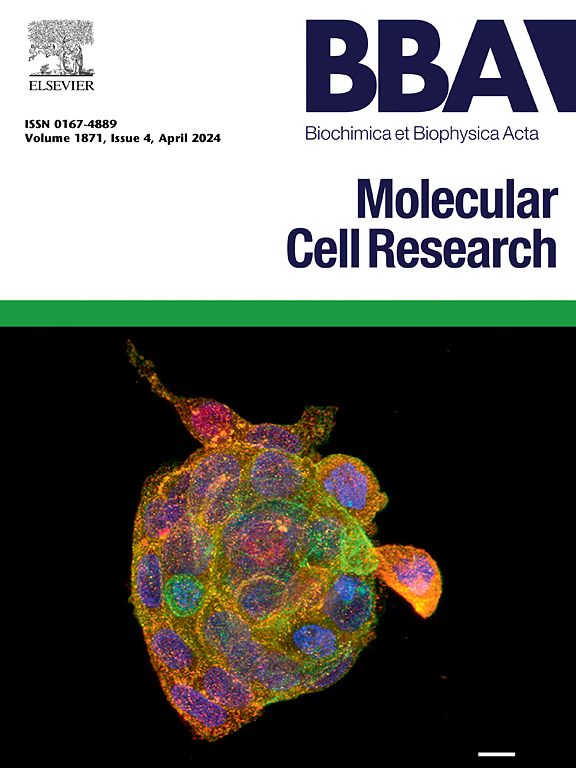Mitochondrial DNA genotypes modify m.3243A>G-associated mitochondrial disease via the 15-HETE/Akt/FoxO1 pathway
IF 3.7
2区 生物学
Q1 BIOCHEMISTRY & MOLECULAR BIOLOGY
Biochimica et biophysica acta. Molecular cell research
Pub Date : 2025-06-30
DOI:10.1016/j.bbamcr.2025.120012
引用次数: 0
Abstract
Mitochondrial disease caused by mitochondrial DNA (mtDNA) 3243A>G mutation is characterized by high levels of clinical heterogeneity. Varied m.3243A>G mutation loads among patients are used to, but cannot fully explain, disease heterogeneity. Here, we found that mtDNA genotypes (haplogroups) modify m.3243A>G-associated natural selection and cell fate determination. mtDNA haplogroup M7 was less prevalent in a multi-center m.3243A>G disease cohort. Further functional studies using cybrids showed that M7 accelerated cell proliferation and shortened G0/G1 cell cycle when compared with cybrid carrying a non-M7 haplogroup (D5). However, mitochondrial function and cell viability were even worse in M7 cybrid than D5 cybrid when treated with mitochondrial oxidative phosphorylation (OXPHOS) inhibitors, indicating that M7 drives negative selection in patients with m.3243A>G during evolution. By adopting multi-omics strategies, we showed a lesser increase of 15-hydroxyeicosatetraenoic acid (15-HETE) levels in M7 cybrid owing to OXPHOS inhibition, leading to insufficient Akt/FoxO1 activation and increased apoptosis. Notably, 15-HETE administration activated Akt/FoxO1 phosphorylation and abolished apoptosis difference between M7 and D5 cybrids, suggesting that augmented 15-HETE was vital to protect cells from death. Collectively, our work identified a genetic modifier of m.3243A>G-associated mitochondrial disease and demonstrated that the mitochondrial retrograde 15-HETE/Akt/FOXO1 signaling cascade plays an important role in protecting cells from OXPHOS dysfunction-induced cell death.
线粒体DNA基因型通过15-HETE/Akt/FoxO1途径修饰m.3243 a > g相关线粒体疾病。
线粒体DNA (mtDNA) 3243 A > G突变引起的线粒体疾病具有高度的临床异质性。不同的m.3243 A > 患者之间的突变负荷习惯,但不能完全解释疾病的异质性。在这里,我们发现mtDNA基因型(单倍群)修饰m.3243 A > 与g相关的自然选择和细胞命运决定。mtDNA单倍群M7在多中心m.3243 a > G疾病队列中较少流行。进一步的功能研究表明,与携带非M7单倍群的杂交体相比,M7加速了细胞增殖,缩短了G0/G1细胞周期(D5)。然而,当线粒体氧化磷酸化(OXPHOS)抑制剂处理时,M7细胞系的线粒体功能和细胞活力甚至比D5细胞系更差,这表明M7在进化过程中驱动m.3243 A > G患者的负选择。采用多组学策略,我们发现由于OXPHOS抑制,M7杂交细胞中15-羟基二碳四烯酸(15-HETE)水平增加较少,导致Akt/FoxO1激活不足,细胞凋亡增加。值得注意的是,15-HETE激活了Akt/FoxO1磷酸化,并消除了M7和D5杂交体之间的凋亡差异,这表明15-HETE的增强对保护细胞免于死亡至关重要。总之,我们的工作确定了m.3243 a > g相关线粒体疾病的遗传修饰子,并证明线粒体逆行15-HETE/Akt/FOXO1信号级联在保护细胞免受OXPHOS功能障碍诱导的细胞死亡中起重要作用。
本文章由计算机程序翻译,如有差异,请以英文原文为准。
求助全文
约1分钟内获得全文
求助全文
来源期刊
CiteScore
10.00
自引率
2.00%
发文量
151
审稿时长
44 days
期刊介绍:
BBA Molecular Cell Research focuses on understanding the mechanisms of cellular processes at the molecular level. These include aspects of cellular signaling, signal transduction, cell cycle, apoptosis, intracellular trafficking, secretory and endocytic pathways, biogenesis of cell organelles, cytoskeletal structures, cellular interactions, cell/tissue differentiation and cellular enzymology. Also included are studies at the interface between Cell Biology and Biophysics which apply for example novel imaging methods for characterizing cellular processes.

 求助内容:
求助内容: 应助结果提醒方式:
应助结果提醒方式:


